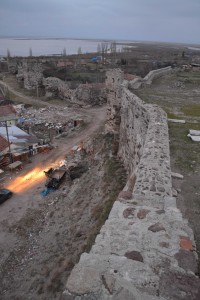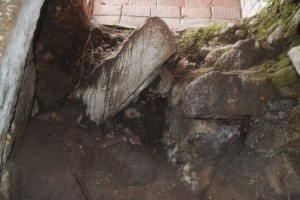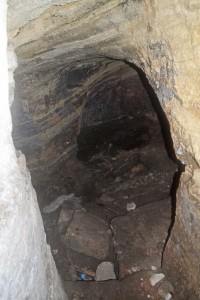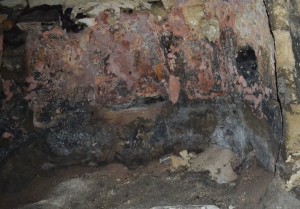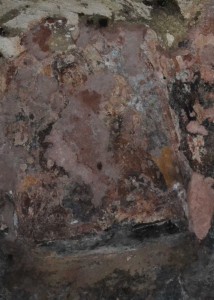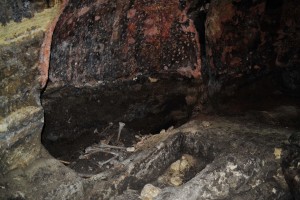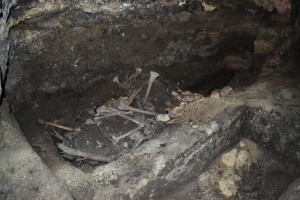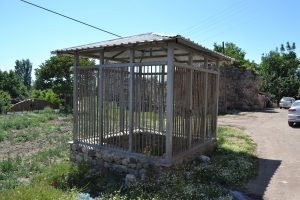Immediately to the south of the wall of Enez Kalesi is the astonishing Chapel of Aya Triada. This is a natural cave which appears to have been used by humans since Hellenistic times and probably before. The entrance is covered by a brick hovel at the edge of a field of rubble. It is an unpromising place for archaeological enlightenment.
So you go into the shed and find that it contains a hole in the ground. The only way down is to place your hands either side of the hole and lower yourself down. Then you’re face-to-face with a Hellenistic face of Pan. This is what gave the cave one of its names. Apparently there was a niche with a marble relief of Pan dancing with two nymphs. This appears to date from the fourth century (Isaac, p157). A mini landslide has obscured most of this for now.
Most of what remains is a 14th century burial chapel. The 12m x 7.5m chamber has been carved into the rough shape of a Byzantine church. There is a central apse flanked by smaller ones. The ceiling is barely smoothed at all. The chapel is covered with the remains of fresco decoration, all in bad condition. The large apse still has a recognisable Virgin Mary fresco. The cave was reportedly used as a tinsmith’s workshop during the 20th century. Tinsmiths are frequently noted for their artistic sensibility. Perhaps not this one.
The oddest feature of the cave chapel is the scattered human bones. They have probably been left by treasure hunters excavating the five graves aligned along an east-west direction. It’s an odd experience to be in subterranean darkness and surrounded by Byzantine skeletons.
In May 2017, the cave had been enclosed with a neat and purposeful wall and cage. The days of unfettered exploration are over. Hopefully, so is the vandalism.
Ceylan, S. (2015) Enez (Edirne) İlçesi’nin Turistik Çekicilikleri ve Sürdürülebilir Turizm Açısından Değerlendirilmesi (Touristic attractions of Enez (Edirne) and the evaluation of these attractions regarding maintainable tourism. Available online at http://tucaum.ankara.edu.tr/wp-content/uploads/sites/280/2015/08/semp5_40.pdf [9] Accessed 6th Feb 2016
Isaac, B. (1986) The Greek Settlements in Thrace before the Macedonian Conquest. E. J. Brill, Leiden. Available online at: https://books.google.com.tr/books?id=LcfLKHVi2UUC&redir_esc=y [10] Accessed Feb 23rd 2016
Istanbul Üniversitesi Enez Bölgesi Kazı (2013) Pan Cave Grave Chapel – Haghia Triada. Available online at http://enezkazisi.org/?page_id=2682&lang=en [11] Accessed 6th Feb 2016
Tanindi, O., Ö. Kurt et al., 2009, Archaeological Destruction in Turkey, Year 2008 Preliminary Report – Marmara Region Byzantine Period, TAY Project – Scientific Reports Series 16/Eng, ISBN 978-975-807-230-9, Istanbul. Page 55. Available online at http://www.tayproject.org/downloads/Rap/Dest_Rep_08_Mar_Byz.pdf [12] Accessed 6th Feb 2016
